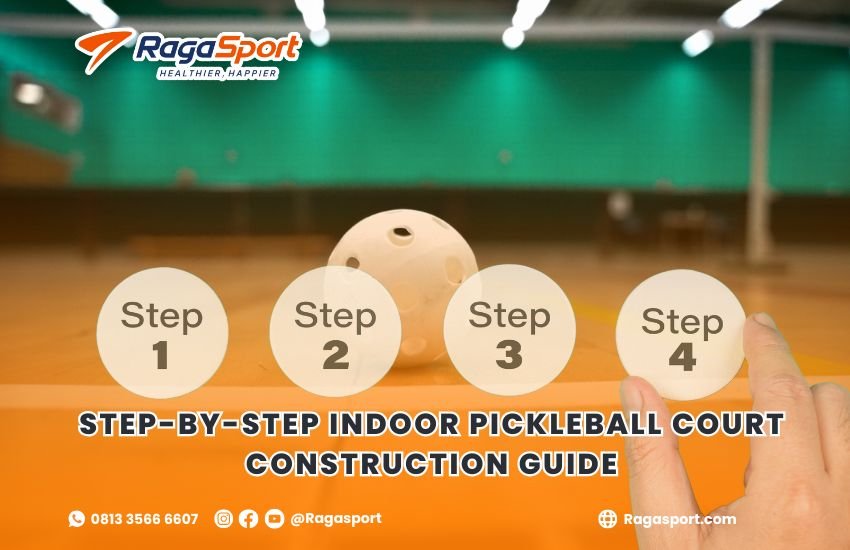Step-by-Step Indoor Pickleball Court Construction Guide
Building an indoor pickleball court requires more than simply finding a space and painting lines. It involves proper planning, surface preparation, lighting, and equipment installation to meet performance, safety, and durability standards. Whether for a commercial sports facility or private use, this step-by-step indoor pickleball court construction guide will walk you through every critical stage of the process.
Table of Contents
1. Assess Space and Dimensions
Before construction begins, evaluate the available space to ensure it meets regulation standards. A standard indoor pickleball court measures:
- Playing area: 20 feet wide by 44 feet long
- Recommended total space: 30 feet wide by 60 feet long (for safe run-off zones)
The ceiling height should be at least 18–20 feet to accommodate lobs and gameplay. Make sure the area is free from columns or obstructions that could interfere with play.
2. Choose the Right Flooring Material
The flooring is one of the most important components of any indoor pickleball court. It should provide consistent bounce, player comfort, and durability. Top choices include:
- Polyurethane sports flooring: Shock absorbent, seamless, and easy to clean
- Modular polypropylene tiles: Offer easy installation and good traction
- Vinyl composite tiles: A budget-friendly option with multi-use flexibility
Avoid concrete-only surfaces indoors unless they’re coated with sports-grade material, as they can increase the risk of injury and provide inconsistent ball bounce.
3. Prepare the Subfloor
A stable and level subfloor is crucial for performance and longevity. The surface should be:
- Clean, dry, and free from debris
- Smooth and properly cured if concrete is used
- Moisture-sealed to prevent damage from humidity or leaks
Subfloor imperfections can lead to uneven surfaces and premature wear of the flooring material.
4. Plan and Install Lighting
Proper lighting is essential for indoor pickleball courts, especially for competitive or high-traffic play. Ideal lighting design includes:
- Uniform distribution across the entire playing area
- Minimum of 50 foot-candles for recreational play, 75–100 for competitive
- LED fixtures mounted at the correct height and angle to minimize glare
- Dimmable or motion-controlled options for energy efficiency
Lighting placement should avoid casting shadows on the court, which can affect visibility and reaction time.
5. Mark the Court Lines Accurately
Court markings must be done precisely according to USA Pickleball standards. Key lines include:
- Baseline
- Sidelines
- Non-volley zone (also called the kitchen)
- Centerline
- Service courts
Use durable line paint or inlaid materials compatible with your chosen flooring. Bright white or contrasting colors ensure good visibility under indoor lighting.
6. Install the Net System

A regulation pickleball net measures:
- 36 inches high at the sidelines
- 34 inches high at the center
- Net width: 22 feet including side posts
Choose an indoor net system with a stable base that won’t damage the flooring. If the court will be multi-use, consider a portable net that can be removed when not in use.
7. Ventilation and Climate Control
Unlike outdoor courts, indoor pickleball courts require well-planned ventilation to maintain air quality and comfort. Consider:
- HVAC systems for temperature and humidity control
- Exhaust fans to manage airflow and prevent condensation
- Dehumidifiers in humid regions to protect flooring
A consistent climate helps maintain the playing surface and provides comfort for players.
8. Safety Padding and Wall Protection
Indoor courts often have walls closer to the playing area. Install:
- Wall pads behind baselines or near any structural columns
- Floor mats or rubber barriers around entrances and exits
- Clear boundary markings for walkways or non-play areas
These elements minimize injury risk and protect both players and the facility.
9. Consider Additional Amenities
To enhance player experience, include optional features such as:
- Scoreboards and timers
- Bleachers or viewing areas
- Changing rooms or locker facilities
- Sound systems or PA equipment
- Branding or sponsor signage
These upgrades can increase the facility’s appeal and functionality for clubs, schools, or commercial operators.
10. Work with Professional Indoor Court Builders
Although DIY options exist, hiring experienced indoor pickleball court contractors ensures:
- Accurate planning and engineering
- Use of professional-grade materials
- Compliance with sport regulations
- A faster, hassle-free installation process
Professionals also offer maintenance services and resurfacing options to keep your court in top condition.

Partner with Raga Sport for Your Indoor Pickleball Court
When it comes to indoor pickleball court construction, Raga Sport offers expert planning, high-quality materials, and complete installation services across Indonesia. Whether you’re developing a community center, gymnasium, or private facility, Raga Sport ensures your court meets all standards for performance and safety.
✅ Full-service court design and construction
✅ Premium indoor flooring systems
✅ Custom features and maintenance packages
✅ Experienced team with proven projects
👉 Visit Raga Sport to explore indoor court solutions
📞 Contact us on WhatsApp for a free consultation and site evaluation

